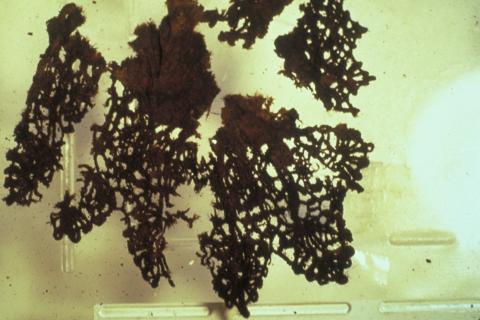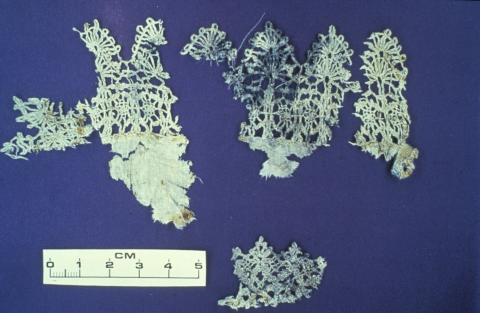Treatments
As many of the current treatments for wet organic objects require access to specialised equipment (analytical and technical) and research into treatments is on-going, an overview of some treatment processes are described rather than specific treatments for particular object types. Contact a conservator to obtain the most up-to-date information.
Generally, treatment of wet organic materials involves four distinct stages:
- cleaning - physical and chemical;
- desalination;
- consolidation; and
- drying.
Physical Cleaning
Clean the surfaces of wet organic objects before chemically treating them. This allows the material type to be determined, improves the rate of outward diffusion of any absorbed salts or corrosion products and improves both the object’s appearance and its permeability to stabilising consolidants.
During cleaning take care not to damage an artefact’s surface as it is important not to remove or disfigure potentially useful archaeological information.
Depending on the nature and condition of the object in question, either remove soil and similar materials by careful brushing in water or use ultrasonic agitation if appropriate. Monitor the removal of detritus through a microscope to ensure that surfaces of small valuable items are not damaged during cleaning.
To minimise the damage to the surface of soft materials like wood, bone and leather, use wooden and plastic scrapers rather than metal ones to remove more stubborn encrustations from the surface. Remove adherent concretion with dental tools or by gentle percussion. Wash off or carefully wipe debris from the surface while keeping the object wet at all times.
The fragility of wet textiles, including rope and matting, complicates their cleaning. Support these materials on either glass, perspex sheets or netting while cleaning them. As brushing will inevitably lead to fibre damage, use a fine spray of water or careful immersion (still on a support) to clean the object. Carefully applied ultrasonic techniques have also successfully cleaned these fragile materials. If possible conduct a test on a sample section before using ultrasonic techniques on a larger scale.
Chemical Cleaning
Organic objects excavated from wet sites will have absorbed substantial amounts of salts from their surroundings. For shipwreck objects the most commonly incorporated materials, apart from the ubiquitous salt, are metal corrosion products which originate from nearby corroding copper and iron artefacts (Figure 5).
Figure 5: (a) Lace from the Batavia (1629) shipwreck before treatment.
(b) The same sample after treatment to remove corrosion products.
In many cases incorporated iron corrosion products are not only disfiguring but chemically damaging to objects. In conditions of elevated relative humidity the presence of iron corrosion products and reduced sulphur in conserved wood for example, leads to the development of damaging acidic regions (Sandström et al 2003). Cellulose breakdown follows. Other cellulosic materials, such as rope and many textiles, are also at risk in the presence of iron corrosion products.
Treatments are aimed at removing these incorporated minerals from organic objects. This is achieved by using chelating or complexing agents to remove the intrusive corrosion products. The chemistry associated with these processes is not simple. It is essential to utilise the services of a conservator who can monitor treatments regularly to determine treatment effectiveness and the rate at which corrosion products are removed.
Desalination
Desalinate wet organic objects before any impregnation or consolidation treatment. Apply the procedures outlined earlier in this book (see the chapter Ceramics). Note that the more porous nature of organic materials means that desalination times will be less than for metals and glass. If necessary incorporate a fungicide in the desalination solution to protect objects while salts are being removed.
Consolidation Treatments
As organic objects deteriorate in a wet environment the soluble degradation products that are generated during this deterioration leach into the surroundings. In many cases the object is bulked by water which takes the place of the leached chemical constituents. This helps to maintain the shape of the object, but only while it is in its wet state. Unfortunately, as drying takes place supporting structures are lost and cell collapse, shrinkage and warping result.
The aim of consolidation treatments is to prevent this damage by progressively replacing the water in degraded organic objects with chemicals (consolidants and bulking agents) which will bond with the residual chemical constituents of the object. These consolidants provide objects with added structural integrity when they are dried.
If an organic artefact needs to be analysed, sample it before any chemicals such as fungicides or consolidating agents are used to treat it.
Drying
Damage to wet objects becomes obvious if drying is uncontrolled. Wood may warp, crack or shrink, ivory delaminate and leather shrink. Drying damage is irreversible for objects like wood, bone and ivory. Although leather objects can be retreated if their shrinkage is unacceptable (> 5 %), avoid this if possible.
The key to success in drying is to ensure that drying stresses are minimised. Vacuum freeze-drying is the best method to dry objects such as wood, rope and textiles as it gives a much better end product than air drying. This is because the freeze-drying process allows moisture to be removed as vapour directly from ice (sublimation). Drying stresses induced by the strong surface tension forces of water are avoided when the liquid state is bypassed in this way and any water–based consolidants cannot drain away as could happen if the ice reverted to liquid form.
Although vacuum freeze-drying is the most efficient technique, it requires the use of sophisticated and expensive equipment. It is used primarily for drying small objects. A frost-free freezer is also very effective at slowly freeze drying conserved organic objects without the need for an applied vacuum. Monitor the weight of objects as they dry to determine when the drying process is complete.
Controlled air drying is usually needed for larger objects. Controlled dehumidification over a prolonged period is the next best alternative to freeze-drying. This process may involve the use of expensive, electronically controlled dehumidification chambers or improvised materials to construct a chamber in which the temperature and relative humidity can be regulated. One simple way of slowing the drying process is to place objects under polyethylene sheeting, venting the saturated atmosphere that builds up under the plastic once a week. Alternatively, place small objects in plastic bags that have been pierced with pin-sized holes.
As mould formation is enhanced when the relative humidity is high, monitor the progress of drying operations, especially if objects are placed in or under plastic.


